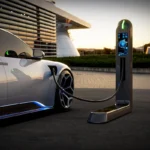The daily commute doesn’t have to drain your energy or empty your wallet. Modern eBikes are transforming how people think about urban mobility, offering sophisticated technology that makes cycling effortless and enjoyable. These aren’t your grandfather’s motorized bicycles – today’s electric bikes feature artificial intelligence, smartphone connectivity, and battery systems that rival electric cars.
Whether you’re a tech enthusiast curious about cutting-edge features or a commuter seeking practical transportation solutions, understanding what makes current models so remarkably advanced can help you make an informed decision about joining the electric cycling revolution.
Menu list
- Intelligent Battery Management Systems Transform Range Anxiety
- AI-Powered Motor Control Redefines Performance
- Connected Ecosystem Features Elevate User Experience
- Cutting-Edge Safety Innovations Protect Modern Riders
- Sustainable Engineering Meets Performance Excellence
- Future-Forward Mobility Solutions
- Investment Value and Cost-Benefit Analysis
- The Electric Future Starts Today
- Common Questions About Advanced Electric Bikes
Intelligent Battery Management Systems Transform Range Anxiety
The foundation of any exceptional electric bike lies in its power source, and modern battery technology has eliminated the dreaded range anxiety that once plagued early adopters. Today’s eBikes feel incredibly advanced thanks to the integration of smart systems that respond in real time to terrain, speed, and rider input. These features allow for dynamic power adjustment, improved energy efficiency, and enhanced safety without the rider needing to make manual changes.
The isinwheel gt2 electric scooter reflects this smart upgrade with precision engineering and intelligent controls that deliver a fluid, high-performance ride. From adaptive braking systems to app-based customization, these innovations give riders a sense of control and confidence that traditional bikes simply can’t match.
Adaptive Power Distribution Technology
Today’s advanced electric bikes don’t just store energy – they think about how to use it. Real-time optimization systems analyze your pedaling style, the terrain ahead, and even weather conditions to distribute power efficiently. These smart battery cells monitor individual performance, preventing overheating and extending overall lifespan.
In the Portland study, it was found that e-bikes emit 4.9g of CO2 per person mile, taking into account the carbon cost of the electricity generated in the region. This compares extremely favorably with the 140g of CO2 per person mile from public transport, and a massive 274g emitted by cars. Smartphone apps now provide predictive range calculations, telling you exactly how far you can travel based on your intended route and riding preferences.
Revolutionary Fast-Charging Solutions
Gone are the days of overnight charging sessions. Modern lithium-ion innovations deliver 80% charge in under two hours, while removable battery designs let you charge conveniently indoors. Some models now feature solar charging compatibility and regenerative braking systems that actually add power back to your battery while riding.
Smart battery management provides the energy foundation, but delivering that power efficiently requires equally intelligent control systems.
AI-Powered Motor Control Redefines Performance
Advanced motor technology now works in perfect harmony with these batteries to create an almost telepathic riding experience that responds instantly to your needs.
Torque Sensor Integration and Predictive Assistance
The latest smart eBike technology reads your pedaling force in real-time, delivering power that matches your natural rhythm. Machine learning algorithms actually adapt to your individual riding patterns over time, creating a personalized assistance profile. This intelligent system prevents motor strain and extends component lifespan significantly.
Multi-Modal Drive Systems
Hub motors and mid-drive motors now feature advanced configurations that optimize performance for different riding conditions. Dual-motor setups provide enhanced traction and power distribution, while automatic gear shifting synchronizes perfectly with motor assistance. Understanding how eBikes work requires appreciating these sophisticated power delivery systems that seamlessly blend human and electric power.
Seamless power delivery and motor intelligence create an exceptional riding foundation, yet modern electric bikes go far beyond just pedaling assistance.
Connected Ecosystem Features Elevate User Experience
Today’s connected ecosystem features transform your electric bicycle into a smart mobility hub that integrates with your digital lifestyle in remarkable ways.
IoT Integration and Smart Connectivity
GPS tracking with anti-theft protection gives you peace of mind, while real-time diagnostics alert you to maintenance needs before problems develop. Integration with fitness apps and social cycling platforms turns every ride into a connected experience. When exploring alternatives to traditional bicycles, personal electric vehicles are expanding beyond conventional designs.
Advanced Display and Control Systems
Color touchscreen interfaces now include navigation capabilities, voice command integration, and handlebar-mounted controls. Customizable riding modes and performance analytics help you optimize every journey, whether you’re commuting to work or exploring weekend trails.
Connected features enhance convenience and performance, but the most critical advancement addresses every rider’s primary concern: safety.
Cutting-Edge Safety Innovations Protect Modern Riders
Revolutionary safety innovations now provide multiple layers of protection that were unimaginable in traditional cycling, making electric bikes safer than ever.
Integrated Lighting and Visibility Systems
Automatic adaptive lighting responds to ambient conditions, while turn signal integration and brake light activation communicate your intentions to other road users. Reflective frame elements and smart helmet connectivity create a comprehensive visibility system.
Electronic Stability and Braking Assistance
Anti-lock braking systems (ABS) for electric bikes prevent wheel lockup on wet surfaces. Traction control adapts to varying terrain, while collision detection and emergency braking features provide additional protection. These systems work together to prevent accidents before they happen.
In New York, pedal-assisted electric bicycles accounted for 35% of all Citi Bike rides, although they make up just 20% of the fleet. On average, a Citi Bike e-bike is ridden 9 times daily, while a pedal bike is only ridden 3.5 times.
Advanced safety systems protect riders while they enjoy their electric bikes, but conscious consumers also want to protect the environment.
Sustainable Engineering Meets Performance Excellence
The marriage of cutting-edge performance with sustainable engineering practices proves that eco-friendly doesn’t mean compromising on capability or innovation.
Eco-Friendly Materials and Manufacturing
Carbon fiber frames now incorporate recycled components, while biodegradable packaging and sustainable supply chains reduce environmental impact. Energy-efficient production processes are significantly reducing the carbon footprint of manufacturing.
Modular Design Philosophy
Upgradeable components extend electric bike lifespan, while standardized battery compatibility across brands reduces waste. 3D-printed custom parts and accessories enable personalization without compromising sustainability goals.
Sustainable design principles are shaping today’s electric bikes, but the technology is advancing so rapidly that tomorrow’s features are already emerging.
Future-Forward Mobility Solutions
These future-forward innovations promise to revolutionize not just individual riding, but entire urban transportation networks in ways we’re just beginning to understand.
Autonomous Riding Assistance Features
Self-balancing technology enhances stability for new riders, while automated parking and docking capabilities simplify urban storage. Predictive route optimization based on traffic patterns helps you avoid congestion and arrive faster.
Integration with Smart City Infrastructure
Vehicle-to-infrastructure (V2I) communication protocols enable electric bikes to communicate with traffic systems. Smart traffic light synchronization and dedicated bike lanes with charging stations represent the future of urban mobility.
While autonomous features and smart city integration represent the exciting future, today’s specialized applications are already transforming specific industries.
Investment Value and Cost-Benefit Analysis
The investment value extends far beyond the initial purchase price when you consider the total cost of ownership and comprehensive lifestyle benefits of eBikes.
Total Cost of Ownership Advantages
Maintenance savings compared to traditional vehicles add up quickly, while insurance and registration costs remain minimal. Government incentives and tax benefits make the financial equation even more attractive for many buyers.
Health and Lifestyle Benefits Quantified
Fitness tracking integration measures tangible health improvements, while mental health benefits of outdoor cycling activities enhance overall well-being. Time savings in urban commuting scenarios often justify the investment within the first year of ownership.
Understanding the compelling cost-benefit analysis is crucial, but translating that knowledge into the right purchase decision requires a systematic approach.
The Electric Future Starts Today
Modern electric bicycles represent more than just upgraded transportation – they’re sophisticated mobility solutions that seamlessly blend cutting-edge technology with sustainable design. From AI-powered motor control to predictive battery management, today’s models eliminate traditional cycling barriers while providing unprecedented convenience and performance. The environmental benefits, combined with advancing safety features and smart connectivity, make these advanced machines compelling alternatives to traditional vehicles. As urban infrastructure evolves to support electric mobility, early adopters are positioning themselves at the forefront of a transportation revolution that’s reshaping how we move through our cities and communities.
Common Questions About Advanced Electric Bikes
Are electric bikes getting better?
This is changing. The e-bike has undergone a revolution and is currently the most popular bike on the market. Technology has improved, making them safer, more durable, and more reliable, while new laws have been passed that make them legal to operate on roads.
How do modern electric bikes differ from traditional models?
Today’s models feature AI-powered motor control, smartphone integration, predictive battery management, and sophisticated safety systems that weren’t available in earlier electric bicycle designs.
What makes smart technology worth the investment?
Smart features like GPS tracking, maintenance alerts, performance analytics, and mobile app connectivity provide enhanced security, convenience, and riding optimization that justify additional costs.





